MY OAK TREE GROWS IN THE LUBERON
by Susan Manfull
Thanks to a very generous friend, my family and I own an oak tree in Provence. Nestled in the thickly wooded hills of the Luberon between Lourmarin and Cadenet, is a large organic farm called Les Pastras (which means “the pastures,” in Langue d’Oc, the old Provençal language). There, grows our little tree.
Les Pastras is now under the diligent care of Lisa and Johann Pepin, having taken the reins from Johann’s grandparents who purchased the farm some forty-five years earlier. It is comprised 11 hectares (27 acres) of gently rolling, verdant green meadows framed by a luxuriant forest. Clusters of fruit trees are scattered about the land, grape vines traverse it, and rows of oak trees now complement the wild ones that have long grown on the land.
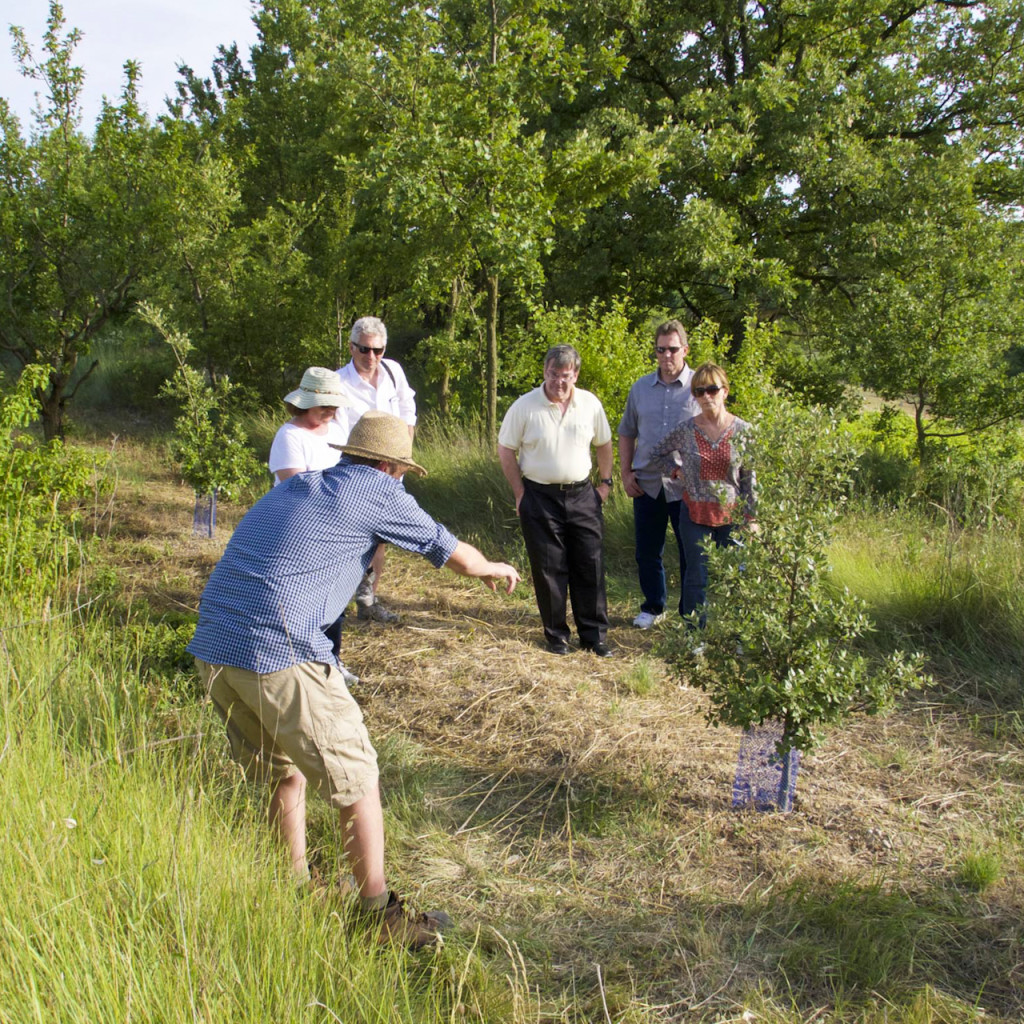
Johann Pepin, who owns Les Pastras with wife Lisa Pepin, points out a sevin-year-old oak tree to members of The Modern Trobadors Tour Group. Photo by Peter Newbury
At one’s disposal, at various times in the year, on this bucolic property are apricots, cherries, plums, apples, pears, pomegranates, figs, almonds, hazelnuts, grapes, olives, and, lest I forget, honey from the bees raised on the property. Most importantly, from mid-November through mid-March, there are winter truffles growing around the oaks…including, fingers crossed, my Oak tree.
When our good friend bought the tree for us back in this summer’s brutally hot June—when we were at Les Pastras gathering summer truffles—it was with the knowledge that, come January, we would receive a box of winter truffles (a.k.a., “black truffles,” “Périgord truffles” and, in Latin, as Tuber melanosporum and, in Langue d’Oc, as rabasse).
Our friend knew we love black truffles (as I suppose any long-time reader of The Modern Trobadors could have guessed). Give me a chicken, roasted with sliced truffles tucked under its skin or a creamy pasta tossed with truffle shavings or even some eggs that were stored with truffles and then scrambled and, well, I’m over the moon.
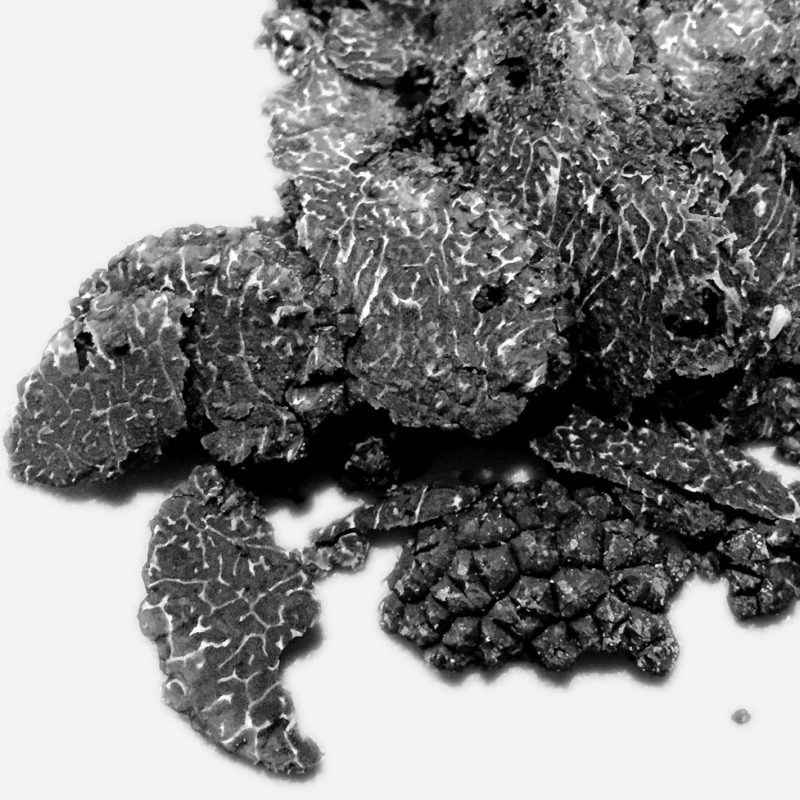
Truffle slices. Photo by WT Manfull
Most people who like food revere this strange, not entirely attractive and arguably stinky, delicacy. So coveted—and difficult to procure—are fresh, authentic black truffles that some folks just call them “black diamonds.” Yes, they are expensive (but when you own an oak tree in Provence, they are a wee bit less).
Les Pastras supports about 500 oak trees, many of which are quite young. When “truffle oaks” are purchased, they come inoculated with thousands of truffle spores. Very few will grow and it takes about 7 to 10 years to see whether the spore will mature and as long as 15 years to determine if the tree will produce truffles. So, until our little oak tree is mature enough, I will keep sending positive thoughts to the older oaks. May they be good role models.
The majority of truffles come from France and about 80% of those truffles hail from the Provence. Spain and Italy are also major players in the Tuber melanosporum market, followed by Australia and the United States.
It has long been known that black truffles are happiest growing near the roots of oak trees (although they will grow, begrudgingly, near the roots of poplars, hazels, pines, lindens, hornbeams, and willows).
Truffles have a symbiotic relationship with these trees. They form networks of fungi (about four inches or so under the ground) that are mycorrhizal; that is, they help supply essential nutrients and water to the tree and, in turn, receive sugars from the tree (a sort of indirect photosynthesis). Animals, such as squirrels, depend on truffles as a food source and truffles depend on those animals (as well as those who prey on those animals, like the owl who eats the squirrel) for spore distribution (via their feces). And, the animals depend on the trees to live in. (It is a really cool eco-system!)
Since last summer, I have been thinking positive, hoping that our little oak tree would be one of the lucky ones with subterranean fungi forming complicated networks encircling the tree. I envisioned our tree surrounded by the “witch circle,” a clearing around the tree caused by the truffle spores having killed the ground-cover. I pictured flies lurking around the cleared ground, a sign that one of several particular species of “truffle” flies had left its larvae about six inches below the ground because truffles were growing in the area. (Both the witch circle and hovering flies are signs truffiers look for to locate les truffes.)
It was easy to picture our tree because the Pepins sent us a large envelope of information about our adopted tree. Along with a lovely letter of introduction, we found a photograph of the little fellow, along with a certificate of ownership, the GPS coordinates of our tree, a Google Earth peak at it—ours is circled in red—and its number. It’s No 88. Armed with this material, I could really home in on our tree.
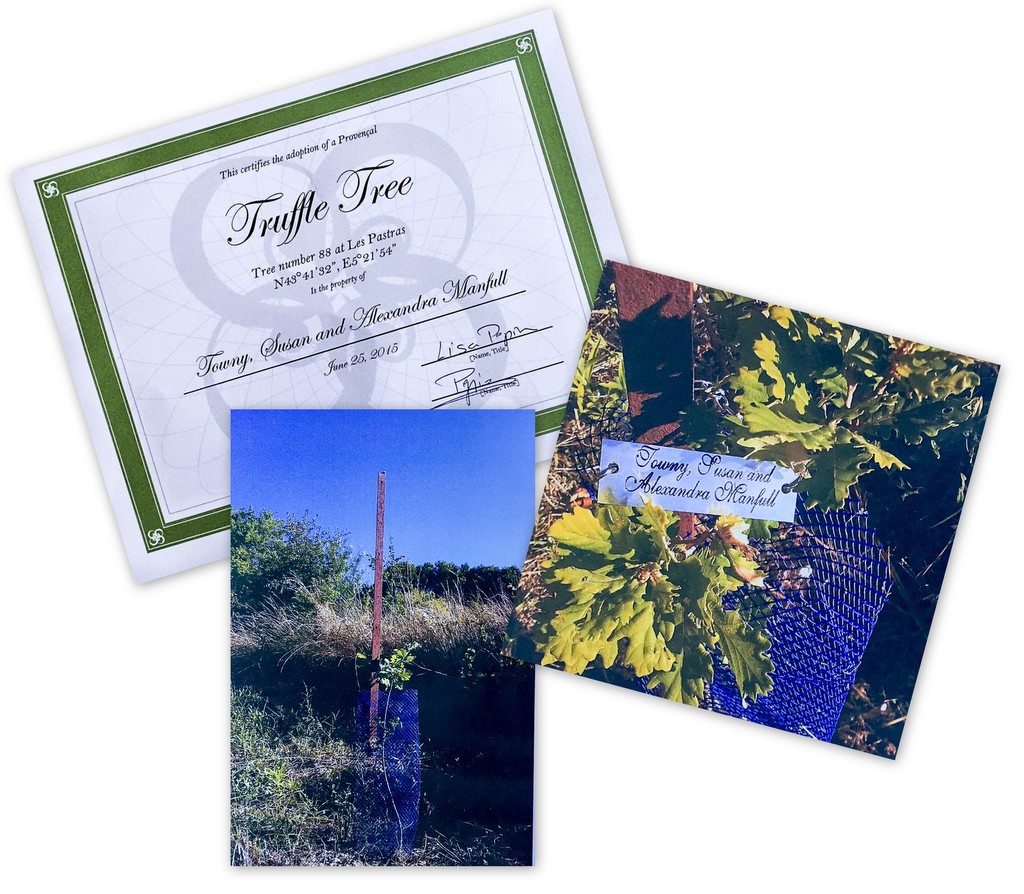
Our certificate of ownership of our “Truffle Tree,” identification of our tree, and our little oak tree. Collage by WT Manfull
I imagined Mirabelle and Éclair, the two four-legged truffle hunters we had met when we visited Les Pastras in June. Éclair was just beginning her training at that time, under the tutelage of a very experienced truffle hunter (who requested anonymity) and Mirabelle was a seasoned truffle dog. Surely, the two truffle dogs would also home in on our tree, the one with the large witch circle and swarm of flies.
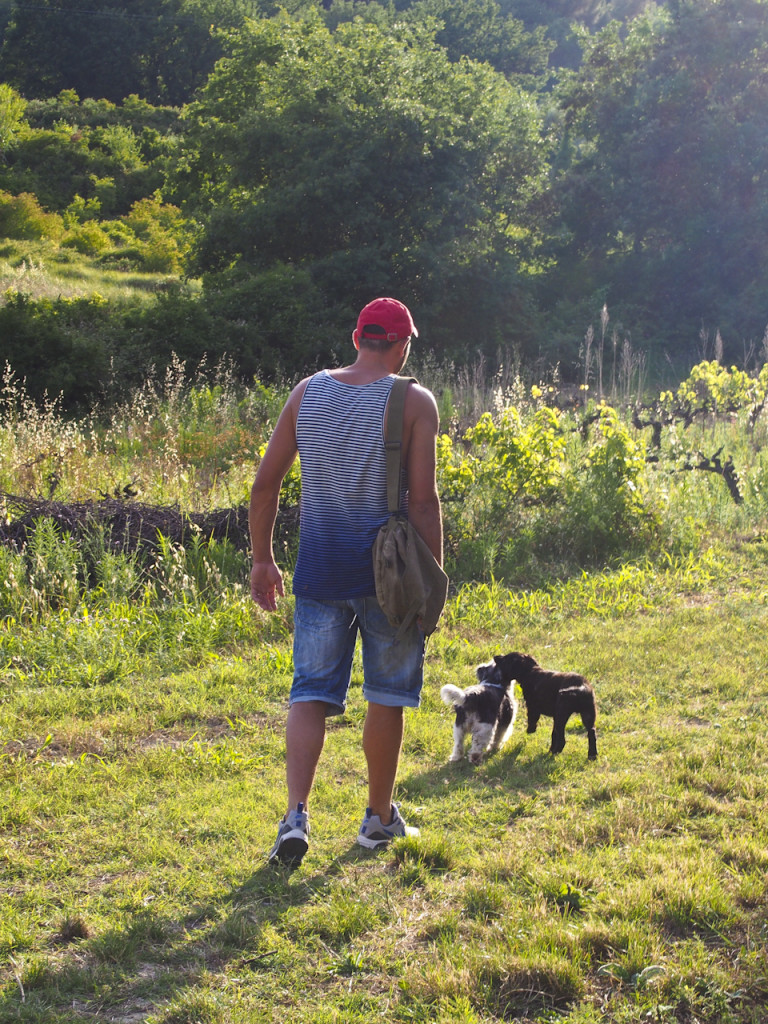
The truffle hunter with Mirabelle and Éclair. Photo by WT Manfull
I even communed with Mother Nature, pleading for favorable weather conditions for the successful growth of all Les Pastras oaks and the whole kit and caboodle of fruit trees, grapevines and bees. To grow best, truffles prefer relatively cool seasons punctuated by moderately hot summers with electrical storms and, most importantly, rain though out the year with sufficient drainage. I prayed for these conditions to prevail.
And, mon dieu, keep the sangliers and voleurs at bay. (Boars and thieves are both serious threats to truffle growers.)
Finally, eight months after meeting the Pepins, I found myself coordinating an approximate arrival date with them for my truffles. On Thursday, February 4, an elegant square, silver box was waiting for me on my table. It was the eve of a major snow storm here in New England, meaning we could be housebound (if we wanted to be) and preparing our little darlings. With visions of truffles dancing in our heads, we were positively giddy.
They were beautifully packed in an insulated container with dry ice packs. The truffles had been perfectly cleaned and dried and then vacuum-sealed. They had been unearthed four days earlier. They were in exceptional condition: firm, no blemishes, and very fragrant. The five or six truffles totaled at least 100 grams What an incredible treat!
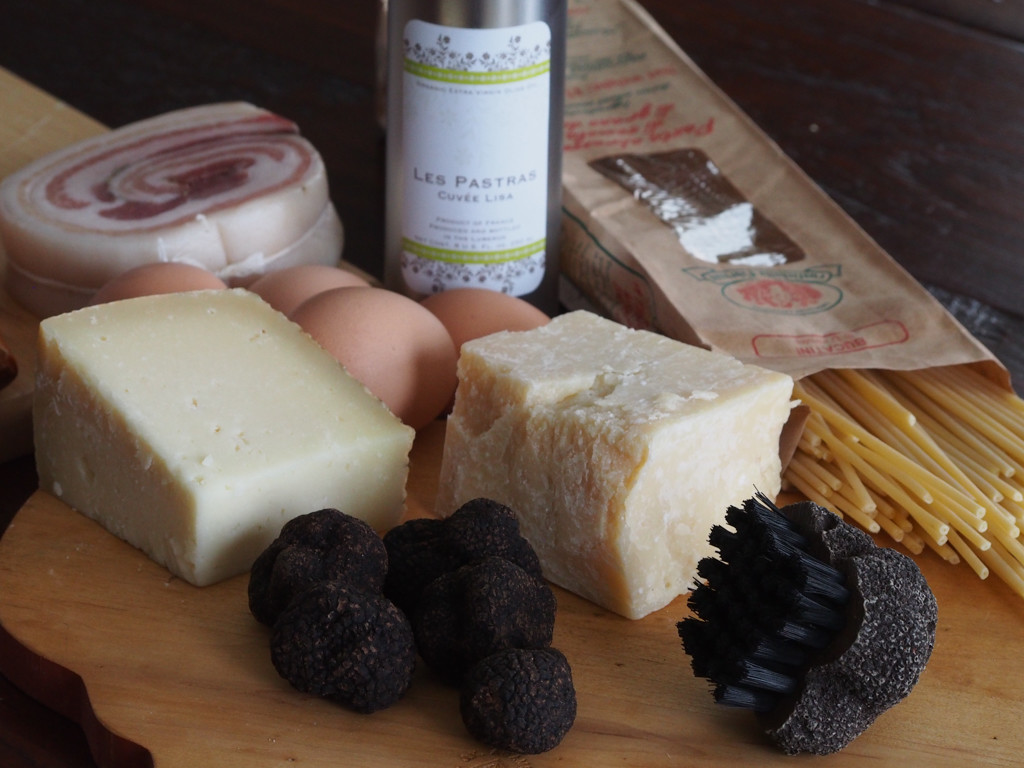
Getting ready to prepare Spaghetti Carbonara with Truffles. Photo by WT Manfull
What would we make? Truffles like fat and minimal cooking. I am particularly drawn to a creamy pasta with Parmesan cheese. Toss it with truffle shavings and you have one of the simplest and yet elegant ways to enjoy your truffle. Nothing more except perhaps some mushrooms. Don’t compete with the truffle.
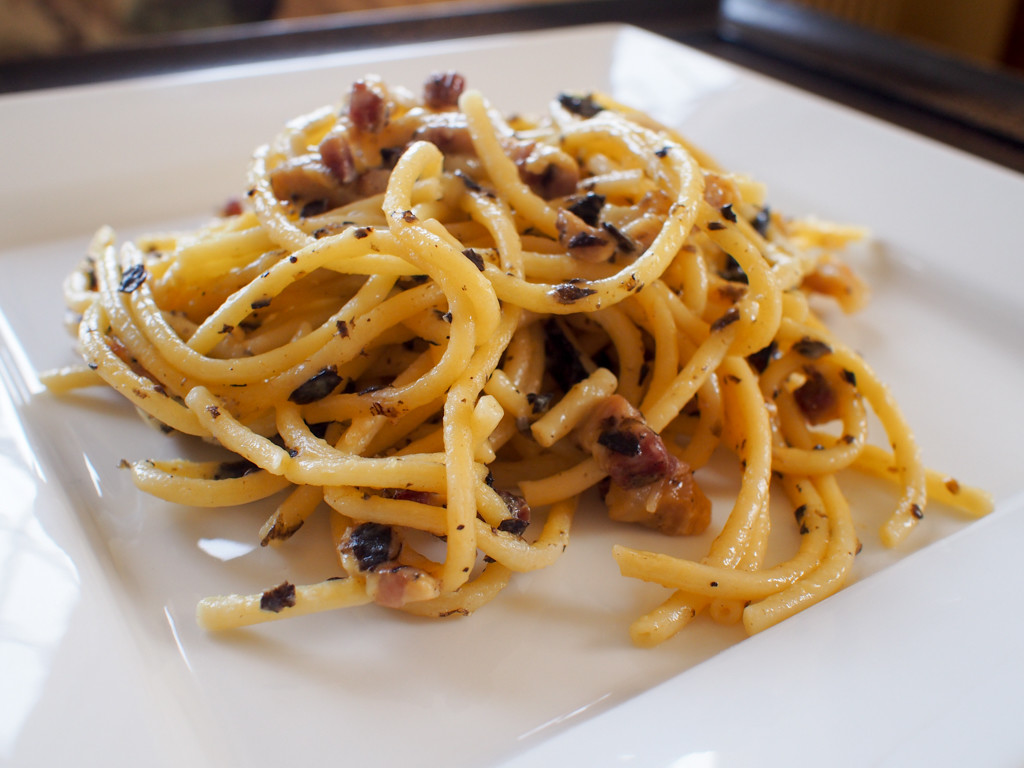
Spaghetti Carbonara with Truffles. Photo by WT Manfull
We made two pastas, some scrambled eggs, and two ramekins of truffle butter. The “Spaghetti Carbonara with Truffles” was based on a recipe from Patricia Wells’ Simply Truffles and the “Penne Pasta with Parmesan and Truffled Butter à la Towny Manfull” was a creation of my husband. Both were outstanding. The scrambled eggs were infused with the flavor of truffles through their storage with several truffles. The truffle butters wait to be tried.
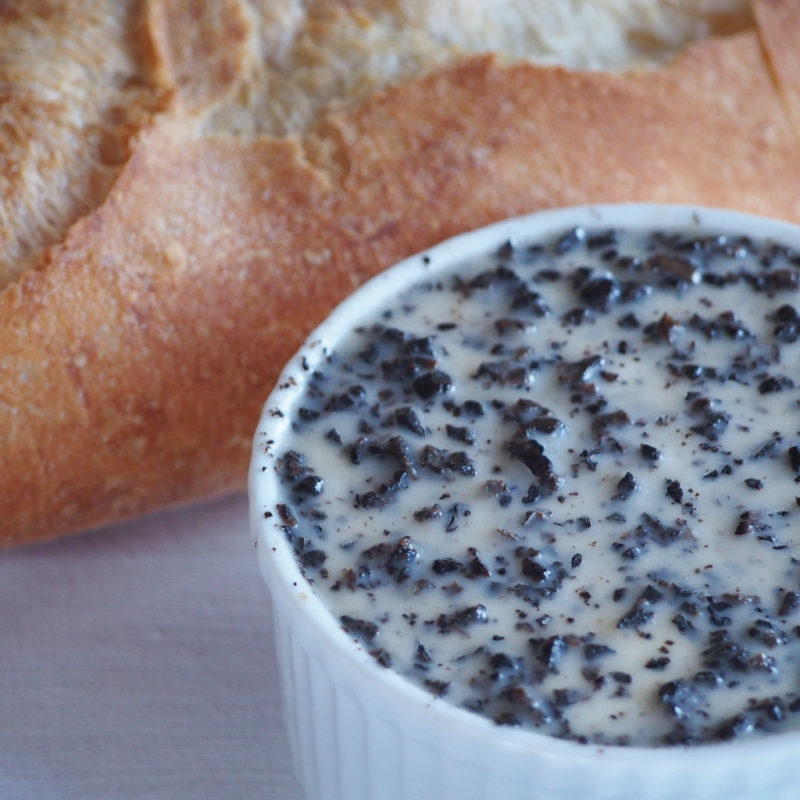
Truffle butter. Photo by WT Manfull
Fresh black truffles bear no resemblance to the truffles one can buy in oil or vacuum-packs. The aroma is earthy although some truffles do remind me of smelly gym socks, these truffles were more reminiscent of umami and damp earth. The taste, like their fragrance is earthy, not unlike a pungent mushroom but something more, too.
They are completely unrelated to most of the “truffle” salts and “truffle” oils sold in specialty stores (except Les Pastras). These salts and oils typically contain a synthetic version of a naturally-occurring compound in truffles called 2,4-Dithiapentane, added to flavor the salt or oil (or potato chips or popcorn described as “truffled”) and most of these are not pleasant or worse. (Always check the label!)
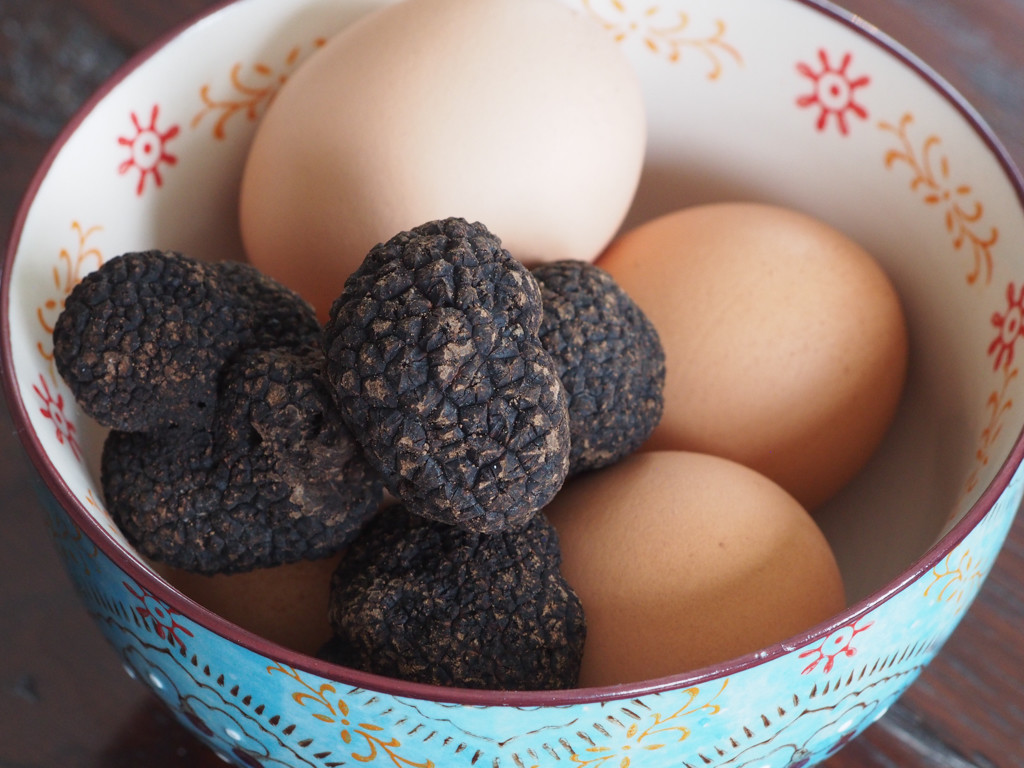
Infusing eggs with the scent of truffles (to make scrampled eggs. Photo by WT Manfull
It was a long weekend of culinary decadence in our home and we look forward to more of the same with the truffle butter!
Do you recall I mentioned the olive trees? The Pepins harvest those olives and take them to a nearby Co-Op to have their own Organic Extra Virgin Olive Oil made from all those olives. It has a deliciously rich and fruity aroma and taste.
And some of that olive oil is infused with Tuber melanosporum to make an exquisite “Black Truffle Oil.” We sample a little truffle oil that lovely June evening we visited Les Pastras. I loved it so much, I picked up a small can as well as a jar of exceptionally good truffle salt. I see an Artichoke Soup in our future.
It may be brutally cold outside in New England these days but the kitchen is hot these evenings….thanks to a little oak tree in the Luberon and a generous friend.
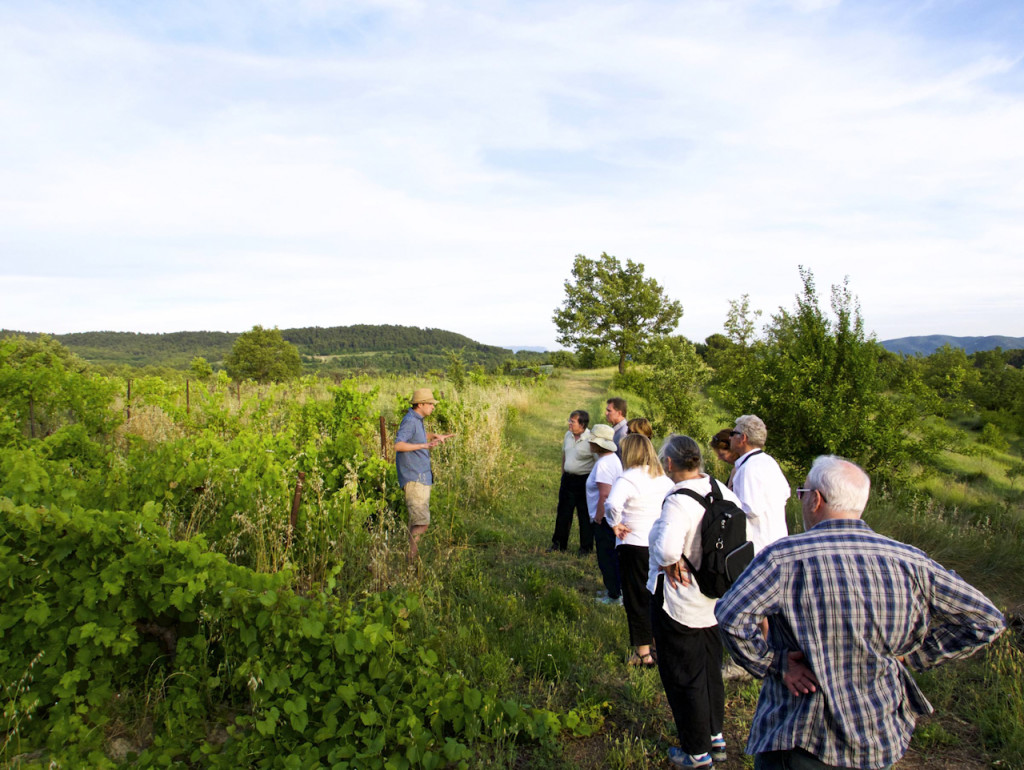
Johann Pepin, who owns Les Pastras with wife Lisa Pepin, points out a sevin-year-old oak tree to members of The Modern Trobadors Tour Group. Photo by Peter Newbury
Notes:
If you are interested in visiting Les Pastras—perhaps doing a little truffle hunting yourself—or in adopting a tree and purchasing other products, please visit their website: www.LesPastras.com
The Modern Trobadors Tour—a small group tour led by none other than moi and husband Towny—also visits Les Pastras! Join us for a summer truffle hunt in June—Two Tours this June!—and for a “Grape Stomp” in September. Please visit our website: www.themoderntrobadors.com/our-provence-tours/
A special bonus to adopting a tree—in addition to the truffles—is that the “adoption fees” not only go toward the care and maintenance of your oak tree but they also contribute to the maintenance of a rainwater irrigation system that provides water to the oak trees without wasting natural resources. And, with each oak tree adoption, a fruit tree is sent to the One Family Orphanage in Haiti. I think there is some symbiosis in this network, too!
Thank you to Photographer Peter Newbury for contributing photographs.
Should we ask Nicki Minaj what her favorite truffle butter recipe is?
You may also be interested in reading:
Summer in Provence: A Surfeit of Truffles
Longing for Black Truffles, Consoled by Fragrant Memories and Patricia Wells’ Simply Truffles
Aups Truffle Festival: Meet the Best Truffle Dog and the Cutest Truffle Pig
Ten Gendarmes in the Market of a Tiny Village in Provence in January: Mais Oui, It’s Truffle Season
Our Brief Foray into the World of Truffle Hunting
Life in Black and White
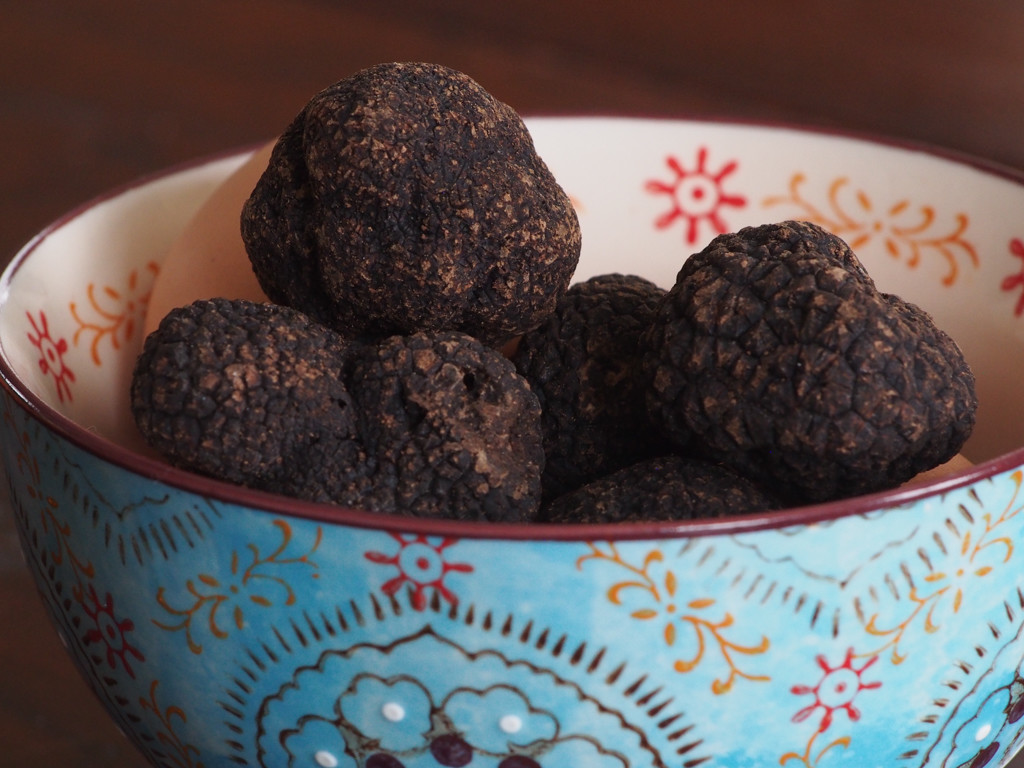
Tuber melanosporum from Les Pastras. Photo by WT Manfull

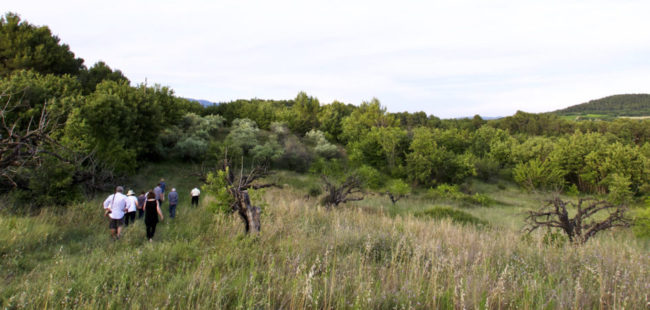
After reading this fascinating truffle tree story I must go back and re-think my idea of getting a star named after me for future generations of Clark’s, and related kith and kin, to peruse under a telescope. A personal truffle breeding tree in the Midi is sometime not to just look upon, and likely will be standing for several hundred years.
Very true. It’s your obligation to adopt one for future Clarks! You might need to adopt three!
And here I had been working on my talk to the grandchildren about the star. “In a galaxy far, far away, your grandfather…”
Oh, I can almost smell that pasta all the way here in Tucson! I am now seriously thinking of adoption… 🙂
A truffle oak transitions into any family with little fuss! Wish we had you cooking in our kitchen and, of course, enjoying the truffled meals around the table!.
Looks incredible! I’d love to be in your shoes! And what did you drink with your pasta??
It was incredible (and still is, as we still have some truffle butter to play with). With the Spaghetti Carbonar, we had a 2001 Cotes-du-Rhone Villages Rasteau from Tardieu-Laurent, courtesy of fellow PWZ writer, Jerry. Fabulous combination! For the Penne, we had a simple Cotes-du-Rhone Villages from Famille Perrin, which was also a lovely marriage although missing the robust elegance of the first red wine. These two meals will certainly be highlights of the winter for us!
Thanks for the memories! The truffle tour at Les Patras last year was a highlight of the tour (one of many!).
Mary, That was a terrific evening, wasn’t it? We will take the tour groups there again this summer and perhaps to the “Grape Stomp” if we do the tour in September!